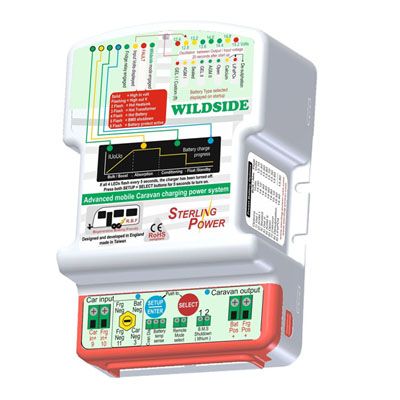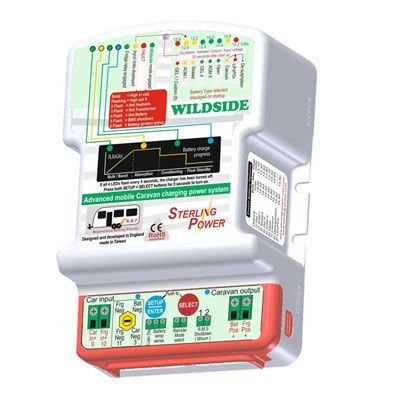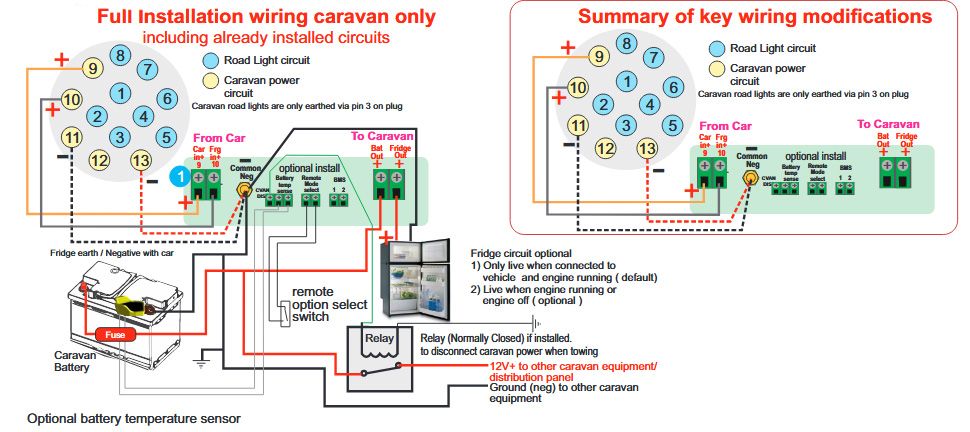Sterling Power BBC1225 Wildside Caravan Battery to Battery Charger PN: BBC1225
Sterling Power Wildside Caravan Battery to Battery Charger
PN: BBC1225
(incl. VAT £273.36)
Battery to battery charger Caravan BBC1225
- Designed specifically for caravan operation.
- Fast charges your caravan battery and runs fridge while towing. 10-20 times charging improvement.
- At least 2 times more useful power available from your batteries due to correct 4 step battery charging.
- Increases battery life again due to correct battery charging curves employed.
- Combats the inherently high voltage drop across long and poor cable runs.
- Prevents current back feeding from caravan battery to the towing vehicle’s starter battery when driving Euro 6.
- No need to upgrade your existing charging cables or plug and socket from your towing vehicle.
- Ideal use with the new Euro 6+ alternator’s voltage characteristic, fixes all problems associated with Euro 6.
- Charges your caravan / mover battery when driving.
- BBC works down to 8V on the input and shall still maintain 14-15V output charging profile at your caravan batteries (dependent on battery type selected).
The electrical requirements onboard caravans have increased in the modern world (laptops/tablets / phones/microwaves/hairdryers / Caravan movers etc.). When at campsites this is no problem thanks to AC hookup. However, if touring is your forte and don't wish the extra cost and limitations at campsites, or simply unable to operate your fridge and charge you caravan/mover battery due to the new euro 6 engines then this is the product for you.
The existing charging off onboard caravans batteries from your main vehicle while in motion is historically terrible. This is because the onboard charging systems have not modernised by keeping up with onboard electrical demands NOR by dealing with the contemporary peculiarities associated with Euro 5 / Euro 6 + engines. A prime example being that some fridges simply do not work whilst towing your caravan and the ability to actually charge the onboard battery is simply out of the question. This is because the towing vehicle alternator’s voltage is dropping below the enabling threshold of the fridge and below that required to charge a battery. Refer to page 15 for Euro 6 / regenerative braking information. We use a van in the test - any modern SUV or car could have also been used. This also drastically effects the performance of the caravan mover rendering this expensive and useful product virtually unless
These problems are totally unnecessary when you consider that modern vehicle have such large alternators and surplus power - much more than their predecessors. Utilizing the alternator’s potential to actually charge your caravan battery fast and fully + running your fridge could free you from constant visits to camp sites when the Wildside option could be enjoyed more and save a lot of money.
A full caravan battery means freedom to enjoy the Wildside experience and allow the installation of more power hungry products such as inverters. Increasing battery banks sizes extends this experience with the knowledge that during your next drive your battery will fully charge from your vehicle. This is something caravanners always assume their system was doing, yet it simply was not.
2 OPERATIONAL MODES:
Battery bias mode (default).
As absorption fridges are very inefficient, they waste a lot of valuable power that could be used to charge your domestic battery/mover battery. Out of the 18A being supplied by the BBC, 13A may be being used for running the fridge, leaving only 5A for charging. Fridges really only needs to be powered 50% of the time to retain their chill. In battery bias mode, we initially focus all the BBC’s power to charge the domestic battery, for 15 minutes (fridge line disengaged). If your domestic battery is nearly full (or full) this time shall be much less. After the 15 minutes (or less), the fridge will come online whilst charging your domestic battery (albeit at a lower rate). The fridge shall come on and remain on provided the domestic battery’s charge level is kept high. If, when the fridge is online and/or the demand from the fridge or a domestic battery load exceeds what the BBC can supply (e.g. 20A+) then the BBC shall prematurely go back to solely charging the domestic battery, thus disconnecting the fridge line. This 15 minutes on and off cycling shall continue thereafter. The ‘fridge relay engaged’ LED shall light when the fridge is online, shall be off during sole domestic charge.
Summary - BBC initially charges solely the domestic battery for 15 minutes or until nearly full. The fridge line is then brought online, whilst maintaining charge to domestic. The fridge remains online indefinitely provided the domestic battery capacity is kept high (14V+). The proviso is that the fridge load does not exceed that of what the BBC can provide. If it does a 15 minute timer begins - then the domestic battery gets sole charge and so on and so forth. Therefore, provided the domestic battery is kept topped up the fridge shall remain online throughout the duration of the trip. If you find that your fridge comes online then trips immediately our algorithm has deemed that the domestic battery has not had sufficient charge, please wait up to another 15 minutes.
Fridge bias mode (press both SETUP and SELECT buttons together for 10 - 30 seconds to engage)
If you want your fridge operating constantly from the BBC supply, then put the BBC into fridge bias mode. The fridge line is constantly online, any surplus current shall be directed to charge up your domestic battery. The ‘fridge relay engaged’ LED shall be on solid as the fridge shall be online. To restore battery bias mode press and hold both buttons down for 10-30 seconds (i.e. repeat procedure).
Analysing the graphs.
First of all I would like to make very clear that this is the absolute best performance you will get. Bear in mind, with this cable I have not added all the plugs, relays and poor connections associated with this circuit on your vehicle for the fridge etc. So, you could only expect lesser performance. Also, the neg was a copper neg return where a lot of people fit the neg to chassis which will make the figures even worse again. So, the above is the best case you can expect, not even the average. The 2 areas to note are the green and purple, the green is the voltage where you need to be to have any chance of charging your caravan battery. The higher up the green area the better your battery charge will be. The purple is your battery depletion, the lower down you are on this the more power you have used and so the more "empty " your battery will become.
The euro 6 + with re-gen breaking vehicles are the most telling. When they are on their low voltage setting ( designed to deplete the engine starter battery about 20% ) they already start out in the battery discharge voltage ( it’s meant to ). However, the voltage which ends up in the caravan under load is way below this due to the voltage drops in the cables. This means your fridge is receiving a very low voltages and it simply cannot operate in the voltage range.
The simple fact of the matter is that with a euro 6 tow vehicle on a caravan will not work the fridge or charge the battery rendering the caravan feed system not functional and totally unless, there is simply no point in having any connection at all .
The solution: the voltage drop down the cabling from the vehicle to the caravan is unavoidable. Also, with new tow vehicles (with euro 6 engines plus) this already poor performance is compounded by the fluctuations between the low 12.6V to high up in the 16V+ region ( highest so far is about 18 V ) .
You may be wondering why, when my fridge, which may be rated at 10A at 12V would be interested in the 12A or 22A graphs. The answer is in the maths. Your fridge may be rated at 10A at 12V = 10 x 14V = 140W. However, when your voltage has dropped to 8.5V (worst case as above) then the fridge power at 120W the maths changes - so 140 W = 16.5 A x 8.5V. Therefore, the amps required is now 16.5 A (also note your fridge would simply not run at this low voltage). What the Sterling Wildside does is to take the low input voltage and current but transform the power from low voltage useless power to much higher voltage useful power. The unit also as a build in 4 step digital constant current programable battery charging system as well as the fridge operation It also reduces the voltages in the event of the re-gen braking high voltage phase attempting to damage any equipment in the caravan. This allows not only your fridge to work but also very effectively charges your battery (better than even the conventional systems).
the above figures are based on an absorption fridge, where ever possible if you want to do a lot of wild side camping you must never use absorptions fridges as their power consumption is insanely higher than a compressor fridge, a typical absorption fridge would have a constant 14 amp draw where as a compressor fridge would average 2 amps hrs
The Sterling system can no longer to be seen as a luxury for increasing the performance of your caravan electrical system but for Euro 6 Plus engines it has now slipped into the category of no Sterling no fridge or Caravan off-site.
The solution needs to overcome the following problems:
1) Deal with the massive voltage drop down the cables/plugs between the car and the caravan by boosting the low voltage to the correct voltage expected to charge the batteries. Also, reducing the voltage during the voltage highs associated with the new euro 5-6+ engines to prevent damage to equipment.
2) Utilize as much of the standard plug and wiring system as possible to avoid changing the basic system - for the sake of ease of installation.
3) Enable the fridge to operate ( 12V aspect ), in transit, or remain ( optional setting ) in operation if not connected to 230V.
4) Charge the onboard batteries fast using a 4 stage charging profile + 9 battery type programmes available. This ensures the battery is fully charged. Plus, a custom set option allowing the unit to be set up to any customer’s personal choice. This ensures your electric caravan mover works when you arrive at your destination.
5) Present the owner with a financial ‘payback’ from the product’s installation. Campsite savings + battery longevity.
6) Supply easy option modes to cover DC fridges, touring or site modes.
7) Add extra safety features, such as: Low battery fridge disconnect to allow lights to work after fridge has been disconnected in the event of battery discharge.
1) A clean and simple install in the main charging cable via the conventional socket. The conventional socket is rated to about 20A. However, it is more like 2-3A. The addition of the 20A battery to battery charger (BBC1225) will dramatically increase that charge rate and shall also compensate for all the problems associated with euro 5-6+ engines. Likewise, if you don't have Euro 5-6+, you will still enjoy at least a 500-700% faster charge rate and double your useful battery storage capacity. This constant current charger also enables the battery plates to stay much cleaner and last longer.
Mode select options for 12V / 230V fridges and 12V only fridge.
Wildside mode (AC 230V not available) allows the 12V aspect of the fridge to be engaged directly to the battery when the car has been stopped. This allows the fridge to run directly from the caravan battery on 12V. This obviously increases the battery consumption, however, the battery should be good for a day or so depending on the efficiency of the fridge. A larger battery bank can be installed in the caravan but watch chassis weight restrictions. A low voltage battery trip will disengage the fridge when the caravan battery is low, at approx. 11V.
Camp site mode (AC 230VAC available), this only allows the 12V fridge to operate during transit and will automatically isolate the fridge from the caravan battery when the journey is completed. The fridge should then be connected to the 230V campsite power, to which can receive its power from.
By increasing your battery capacity and charging rate you can then start looking at inverters. These enable use of phone/tablet charging, microwaves, hair dryers, hair straighteners, tools etc. Please look at our new Pro Combi S+ 1600 pure sine wave inverter/charger. Ideal for adding that next level of comfort to your caravanning experience.
During sale periods, please allow some additional time. We will attempt to call or email you if we become aware of an unexpected delay.




